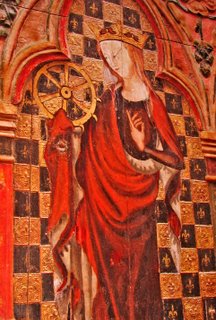Reviving St Catherine's Day
 The following extract is from 'Magnificat' and was written by fr Michael Morris, OP in celebration of St Catherine of Alexandria whose feast is once more kept today:
The following extract is from 'Magnificat' and was written by fr Michael Morris, OP in celebration of St Catherine of Alexandria whose feast is once more kept today:"According to an old English legend of Saint Catherine of Alexandria, her young life of study and learning, of chastity and wisdom, culminated with her baptism and a dream she had thereafter: 'And Mary presented Catherine to the Lord of Glory saying, 'Lo! She has been baptized, and I myself have been her godmother!' Then the Lord smiled upon her and held out his hand and plighted his troth to her, putting a ring on her finger. When Catherine awoke, remembering this dream, she looked and saw the ring upon her finger; and henceforth regarded herself as the betrothed of Christ... thinking only of the day which would reunite her with her celestial and espoused Lord.'
She was reputedly a princess of Egypt renowned for her beauty and intelligence. Through study she was attracted to Christianity, and the vision of mystical marriage crowned her conversion. Constantine the Great was reportedly her relative. But his predecessor in the east, Maximin, was a tyrant who persecuted the Christians. When he arrived in Alexandria, Catherine left her palace sanctuary to openly defend the Christian community. She engaged fifty of his philosophers in pulic debate and converted them all. Her high rank and her youth may have protected her, but she continued to denounce Maximin and his pagan ways. When he tried to seduce her, she rebuked him with horror and disgust. He then threw her into prison where she converted her jailers. Maximin executed all her converts, and planned for her an exquisite death. She was to be tortured and executed on a spiked wheel. But when she was bound to it, a mighty hailstorm fell from the heavens, breaking up the wheel and killing the executioners. She was finally beheaded with a sword.
For nearly a millennium, Catherine of Alexandria was one of the most celebrated female saints of Christendom. She was the embodiment of feminine excellence. She was the patroness of philosophy, of eloquence, or libraries. Her image graced churches everywhere and her symbol of martyrdom, the spiked wheel known as the 'Catherine Wheel' was readily identifiable. Spinners, lacemakers, wheelwrights, cart drivers, ropeworkers, carpenters, millers and anyone working in a trade connected with wheels invoked her aid and celebrated her feast.
And then she disappeared.
With the changes after Vatican II, many of the venerable old saints who had graced the liturgical calendar for centuries were removed to make room for new saints. Saints Christopher, Valentine, Linus, Maurice, Edward the Confessor, and most of the ancient virgin martyrs, like Catherine, were cut from the calendar. Their feasts were no longer celebrated by the universal Church.
As time marches on, new Christian heroes emerge. Yet older saints manage to gain a new significance, like Agatha, who is now invoked against breast cancer, and the plague-saint, Sebastian, who is today invoked by those suffering from AIDS. Significantly, the memory of Catherine of Alexandria managed to endure for the last four decades even though her feast was not celebrated. She remains a potent female figure, so much so that she was recently reinstated on the liturgical calendar. And she returned to her old feast day of November 25.
Angels are credited with having transported her remains to Mount Sinai where an ancient Orthodox monastery founded in the sixth century venerates her memory to this day."

May she intercede for us, students of philosophy, and give eloquence to those who preach the Gospel and study in libraries in preparation for this great work of the salvation of souls. Given her close association with the work of the Order of Preachers, it is unsurprising that she appears (above left) on the Dominican Thornton Parva retable, a copy of which graces our chapel in Blackfriars Cambridge.
On the right is a photo of St Catherine and St Agnes, virgin martyrs, embroidered on a chasuble in the possession of this Priory and used on their respective feast days.







2 Comments:
I also have seen images of St. Catherine of Alexandria in connection with Dominicans. I always thought that whoever connected the two was just ignorant of hagiography--they mixed up Catherine of Siena, with Catherine of Alexandria. Now, I see that I'm the ignorant one. Veritas.
She's my patroness and when I got the habit in '91 Fr. Timothy Sparks, OP (RIP) wrote a letter to the congregation of Saints to ask to have her reinstated!
So, I'm thrilled and we use the troparion and 2 hymns written by Fr. Andrew Hofer, OP.
Post a Comment
<< Home